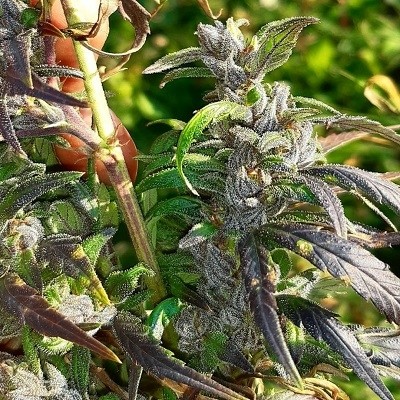
Type : Photoperiod
Sex : Regular
Flowering Time: From 98 to 112 days
Remote Location Near Manipur-Burma Border. Lat. N° 25.09, E° 94.36, approximately at 1500 meters above the sea level (5000+ ft.). The Eastern Manipur region which borders with Burma (Myanmar) has a lush evergreen Hilly terrain. The hills here aren't the same as the ones seen in Himalayan states such as Himachal or Uttrakhand but rather smaller and a mix of undulating topography, larger hills at the periphery and a huge expanse of plain valleys of alluvial tracts shaped by floodings of the region in the past. This region is inhabited by Tangkhul tribe, a sub division of the great Naga or Mao tribe. Manipur has a tropical/subtropical climate for most of the year except the winter months when the rainfall finally takes a break after an average 2000+ mm precipitation during the Summer and extended monsoons. The farmers from this region near the Eastern Manipur-Burma border grow cannabis all around the year thus creating a perpetual harvest like situation. Manipur is located roughly between 24-25°N and undergoes a considerable amount of change in the light hours through summers to winters, however it doesn't snow in the winters and temperatures lurk around 10-15°C which paves the way for a possibility of multiple crops all 12 months. The seeds sown around spring and early summers get a full season and grow tall around 10-11 ft. Although the seeds sown later in the summer stay around a medium stature of 6-7 ft and finally winter sown crops flowers out really small about 4-5 ft avg. Population height since it goes straight into flowering without any veg. Time at all. The tremendous pressure for evermore production of black market cannabis in an overpopulated country is driving these changes from region to region. However, both the winter and the late season (July -August) crops yield considerably lower compared to the prime crop sown with the season but the farmers are happy to take a small dip in the weight instead of waiting through a mild winters without any harvest. The price of mass processed material when taken off the farms is less than $10/Kilo with absolutely no hope of any hike. It leaves no other option for the farmers but to resort to producing more by planting throughout the year and selling a larger qty. Overall to make things work. The full season crop begins to flower around August after at least 3 months of vegetative growth. The full season plants produce heavy lateral branching even without any pruning. The full season crop yields more weight than other two put together which makes it their prime crop and they only harvest these plants when they're fully ripe around the end of January. The plants boast a beautiful combination of lush green leaves with vibrant purple-blue streaked floral bracts packed together like an architectural masterpiece. We selected a few different variations in terms of structure but every sample expressing the similar streaks of colors flowing through the flowers. The smell is very uniform amongst the domesticated heirloom population in this region which closely resembles a complex of caramelised paste of sun dried berries such as blueberry, dried date fruit jam. The captivating blue-purple streaks on the floral bracts could be seen as one of the common traits amongst the domesticated populations even grown at various times of the year. The domesticated heirloom expresses long sleeve like colas with chunky bracts covered in resin and vibrant hues that appear in a peculiar way. It yields heavily due to it's structure that features naturally an aggressive lateral growth. It is abundantly clear that this variety has been selected and domesticated over many generations by the Naga tribes like Tangkhul which was later confirmed by the farmers who own the production field. There were a few variations in the arrangement of the flower clusters but all unique and beautiful in their own right. Thanks to the very easy going folks at the farm who let us document these plants at ease with all the peace of mind in the world. The fresh resin from a very unlikely source like a stick which was being used to beat and flatten the cannabis crops at the farm, yielded a good chunk for sampling the resin. The effects were quite overwhelming in a way that it immediately buckles around the forehead and induces alertness with a heightened sensitivity towards the sounds from the surroundings. The effects last for a considerable duration i.e. easily over an hour and intensifies gradually through the first half creating an overall dreamy surreal high with a prominent massage like feeling around the forehead. Subjectively, the effects are very immersive and engaging, often putting mind on thought trains in many directions. At the pinnacle of Its potential the possibilities seems to be endless in this domesticated heirloom variety. While the trichome size is smaller compared to many other North Indian varieties (like Kashmiri or even varieties from Himachal Pradesh), the effects on the other hand are much more intense in comparison to any other variety from Northern India. The flavours are different though it's basically on a sweeter tangent but in a different way the smell resembles dried berries and date fruit paste. The flowering duration is much longer than highland varieties from north India and stretches up to 16+ weeks with a few early plants finishing around 14-15 weeks.
| Seller |
|---|